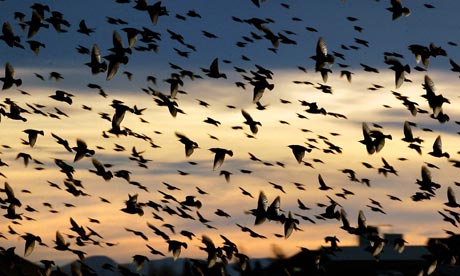
The birds are back in woods behind my house. Wrens, nuthatches, tree-creepers; from first light their bright calls spill into my sleep. After a winter watching a monoculture of jackdaws floating over the lake like delicately made marionettes, the inhabitants of An Atlas of Breeding Birds in Cumbria have begun to spill into the peripheries of my poems.
What is that draws poets to birds? And why have so many turned to them at critical points in their own writing? The collective nouns we all remember from childhood speak of language's innate fascination with all things avian: a murder of crows, a murmuration of starlings, a parliament of fowls. And it's no coincidence we afford them the most poetic collective nouns: right from the birth of literature birds have been present.
In "The Seafarer", the Anglo-Saxon poem of spiritual longing and exile, birds become astringent emblems of solitude as earthly pleasures are traded for the "the gannet's noise and the voice of the curlew" while the laughter of men is replaced by "the singing gull". And once discovered it's hard to shake the haunting, spiritually exact, idea in Bede's Historia Ecclesiastica that our passage through life is like a sparrow flying through the mead-hall on a winter night: from darkness through the bright light and out again into the unknown dark. Later, Chaucer's rhyme royal dream-vision, The Parliament of Foules, sees the bickering birds provide the perfect form for a discussion of love and the imperatives of the natural world (in a poem notable also for the first reference to St Valentine's Day as a day for lovers).
In modern poetry, birds have been just as visible – and not simply as ornament. Ted Hughes found in birds the symbols of his own concerns, first in the shining, terrible, power of The Hawk in the Rain whose "wings hold all creation in a weightless quiet" and later going as far as to forge his own gospel story in Crow.
We see birds ally themselves easily to desire in the Paul Muldoon's "Whim", where two lovers meet over a discussion of which is the superior translation of the poem "Cu Chulainn and the Birds of Appetite" (rendered by the narrator as the salty "How Cu Chuliann Got His End"). They become a piercing motif for the grief we carry through life in Heaney's Blackbird of Glanmore "on the grass when I arrive / filling the stillness with life". The blackbird becomes a bridge to memory of his young brother's death: a symbol of consolation for Heaney but remembered as a portent by a neighbour: "I never liked yon bird".
In his collection Landing Light, Don Paterson signalled his rise to formal and imaginative eminence in "St Bride: Sea Mail" a poem displaying breathtaking control and technique with an awareness of mankind's fragile, often destructive, relationship with the natural world. The poem itself echoes the earlier story of the "candle bird" he tells in "God's Gift to Women" – of a creature valued for its precious oil and rumoured to burn whole should a wick be placed in it.
Paul Farley's "For the House Sparrow, in Decline", meanwhile, tenderly imagines "a roofless world where no one hears your cheeps / only a starling's modem mimicry / will remind you how you once supplied / the incidental music of our lives''. Once again birds provide a metaphor for the crisis of our time.
But poets' relationship with birds is a fragile one, and it isn't always so tender or concerned. Consider the "rapid eyes" of the birds' disquieting presence in Emily Dickinson's "A Bird Came Down" who "bit an angle-worm in halves / And ate the fellow, raw" or Elizabeth Bishop's portrait of the obsessive and obsessed Sandpiper with its "dark, brittle feet". Birds can just as easily lead us into murkier, more disturbed areas of our psyche.
My theory is that birds provide a natural metaphor for the song all poets aspire to. We envy them their ease of expression, as their song provides a bridge into the mysteries of a world the animal in us fondly half-remembers.
Edward Thomas was acutely attuned to the negotiations between the man-made and the natural worlds. It is perhaps no coincidence that in "Adlestrop", his meditation on the strange lacunae of the machine age, that as an express train pulls in at the deserted station and progress and momentum ebbs, we hear a blackbird's song and then simply the song of "all the birds of Oxfordshire and Gloucestershire".

